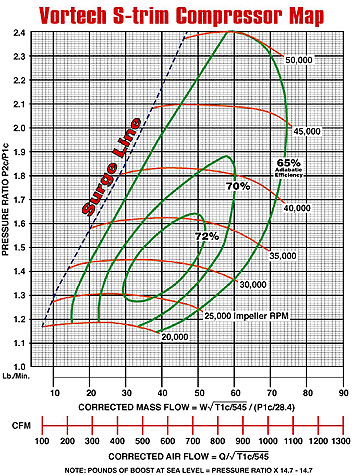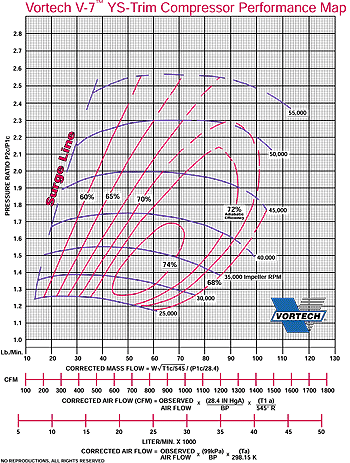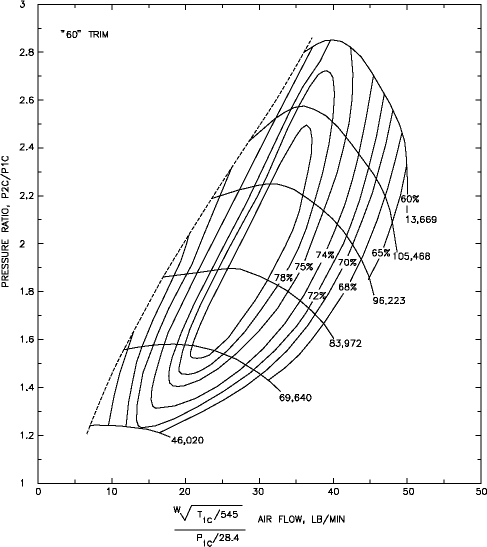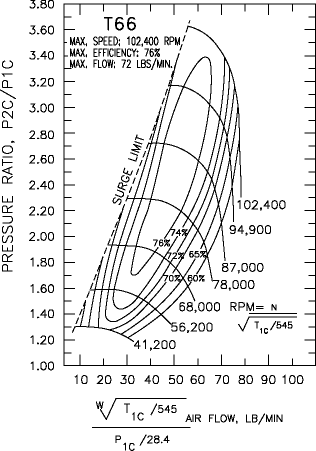Why are turbos and Centrifugal superchargers so different?
#21
Originally Posted by H8 LUZN
a few of you hit it right on the head. its all about efficiency! Power in=power out-losses
The supercharger/compressor system is inherently isentropically inefficient anywhere from 60% to 80% depending on the type which means that its heating the air more than neseccary for the desired boost level. It takes power to compress a certian mass flow of air to a certian pressure, and then you calculate in the extra temperature gain of the inneficient supercharger/compressor.
Also, the problem with adding a restrictor is you are heating the air more than nessecary, basically your pressure ratio (sc outlet/sc inlet) is high which means you have extra temperature yet still low boost so basically its pointless and bleeding off the excess air may be a better idea depending on the efficency range of the supercharger.
But basic laws of phyisics is that you cant create energy only hope to optimize its use for a given situation. any time you bleed air, or add a restrictor you are decreasing the efficency of the system and as a result you are wasting energy.
The best idea mentioned here was the variable pulley which basically ensures the system is only using as much energy as it needs and not consuming extra energy needed to bleed off air.
The supercharger/compressor system is inherently isentropically inefficient anywhere from 60% to 80% depending on the type which means that its heating the air more than neseccary for the desired boost level. It takes power to compress a certian mass flow of air to a certian pressure, and then you calculate in the extra temperature gain of the inneficient supercharger/compressor.
Also, the problem with adding a restrictor is you are heating the air more than nessecary, basically your pressure ratio (sc outlet/sc inlet) is high which means you have extra temperature yet still low boost so basically its pointless and bleeding off the excess air may be a better idea depending on the efficency range of the supercharger.
But basic laws of phyisics is that you cant create energy only hope to optimize its use for a given situation. any time you bleed air, or add a restrictor you are decreasing the efficency of the system and as a result you are wasting energy.
The best idea mentioned here was the variable pulley which basically ensures the system is only using as much energy as it needs and not consuming extra energy needed to bleed off air.

A supercharger's compressor section is generally more efficient at moving air than a turbocharger's compressor section. Just look at the diameter of the compressor wheels and the rpms involved for both. Of course post compressor temperature logs will prove it out along with pressure logging.
A variable pulley is very difficult to build for a serpentine style multi-v belt. They were used on some old centrifugal systems that were driven by V belts. Try to remember those old systems were only there to make 40-60 hp max. A v-belt is not up to the task of driving a high airflow compressor for our performance cars.
The variable inlet is the best overall design and ATI holds at least 4 patents on the technology so maybe we'll get to enjoy
it someday.
#23
TECH Regular
Join Date: Dec 2005
Location: Down Under
Posts: 400
Likes: 0
Received 0 Likes
on
0 Posts
Originally Posted by andereck
You should consider going back to the drawing board, or at least get a dictionary... 

You sir need know what your talking about first off..
(btw.. just because there are patents doesnt mean its perfect or even ideal for that matter..)
First off a centrifugal supercharger is designed for lower RPM's hence the larger size. and the turbo compressor section is generally 'slightly' more efficeint at peak (but again, it totally depends on the specific turbo/supercharger). it is designed in a small package because of the high rpms...
Now if you want to talk positive displacement, they are 'currently' running less efficient than the centrifugal type.
Here are the Maps... im not going to comment, you can see it clearly that they are nearly identical with the peak #'s going to the turbo compressor section..
Here is a Vortech S-trim map

YS Trim Vortech

Here is a TO4E-60 Turbo map

T-66

Oh, and here is the Lysholm Screw compressor found on the ford GT
http://www.opconab.com/www/files/lys...m_lys2300r.pdf
Last edited by H8 LUZN; 02-21-2006 at 06:57 PM.
#24
TECH Addict
Yep the twin screw is not as efficent as a centrfugal, but it is better than a Roots style.
It all depends what you want as every setup has plus' and minus':
- Roots is cheap and can perform pretty well with good low end ability with zero lag.
-Twin screw matches roots for low end and not far behind centrifugal up top zero lag, but is generally very expensive by comparison.
-Centrifugal most efficent supercharger and best PEAK numbers, comparitivly poor low end performance and contains an eliment of LAG (although minor). Pretty well priced also.
-Turbo, ultimate in efficency and PEAK numbers, has good overall peformance and outperforms centrifugal in the low rpm. Suffers from LAG, boost is not prodced from idle and is very costly and often requires a more specific setup for best results (CR and cam selection)
All you need to do is define your goals and budget and see which setup best suits
It all depends what you want as every setup has plus' and minus':
- Roots is cheap and can perform pretty well with good low end ability with zero lag.
-Twin screw matches roots for low end and not far behind centrifugal up top zero lag, but is generally very expensive by comparison.
-Centrifugal most efficent supercharger and best PEAK numbers, comparitivly poor low end performance and contains an eliment of LAG (although minor). Pretty well priced also.
-Turbo, ultimate in efficency and PEAK numbers, has good overall peformance and outperforms centrifugal in the low rpm. Suffers from LAG, boost is not prodced from idle and is very costly and often requires a more specific setup for best results (CR and cam selection)
All you need to do is define your goals and budget and see which setup best suits

#25
Ok, well get ready for some comedy. Since you decided to use these examples here we go:
For these maps we'll assume since we're on LS1Tech.com that we're dealing with a V-8.
The following are close approximations:
30#/min 272hp
40#/min 363hp
50#/min 454hp
60#/min 545hp
Any less is sport compact territory.
A strong running street engine could see 10 psi, I'd say that's probably typical or a touch higher than normally run. This is a pressure ratio of 1.68. We'll round up to 1.70.
Vortech S-trim
30#/min 65% adiabatic eff.
40#/min 70%
50#/min 70%
60#/min 70%
T04e-60
30#/min 78% adiabatic eff.
40#/min 68%
50#/min don't go there
60#/min don't go there
Clearly the turbo used in this example is not suitable for a strong v-8.
The turbo is optimized within a fairly narrow operating range and its pretty difficult to keep it there. In this example its a poor unit for comparison because the mass flow rate just isn't there to support good power. As most turbo setups are wastegate controlled and boost is held more or less constant, the pressure ratio will remain more or less the same. One of the touted benifits of a turbo setup.
The pressure ratio will climb on a centrifugal setup diagonally through the map as airflow increases with engine rpm which coincidentally keeps the blower in a good zone for most of its operating range. FWIW 70% is the lower end for modern compressors. There's been a bunch of work in that area. This is Vortech's entry level blower.
The turbo must increase rpm as engine rpm increases to maintain the mass flow rate required for the set boost level. So since the pressure ratio stays constant you can just plot across the map with your mass flowrate increase. You can see how quickly it falls off as well as the eff%.
Surely there's a better map for comparison since we're discussing compressors for v-8s.
The point is that there is not a huge efficiency gap between turbo's and centrifugals. Many people repeat that like its gospel. It just isn't so.
I'm not a turbo hater at all, I like the discussions about them, but I am a centrifugal man and I can put a blower on your car quicker and for less money that will provide a better driving experience and performance at the track than the vast majority of today's turbo offerrings can as it stands today. For turbo enthusiasts I hope their power adder of choice matures and the kits get better.
I can appreciate performance however its attained. Can you?
edit: the only compressor maps listed by the above poster during my response was the Vortech S trim and the T04E-60. The post still stands against the other posted maps however.
For these maps we'll assume since we're on LS1Tech.com that we're dealing with a V-8.
The following are close approximations:
30#/min 272hp
40#/min 363hp
50#/min 454hp
60#/min 545hp
Any less is sport compact territory.
A strong running street engine could see 10 psi, I'd say that's probably typical or a touch higher than normally run. This is a pressure ratio of 1.68. We'll round up to 1.70.
Vortech S-trim
30#/min 65% adiabatic eff.
40#/min 70%
50#/min 70%
60#/min 70%
T04e-60
30#/min 78% adiabatic eff.
40#/min 68%
50#/min don't go there
60#/min don't go there
Clearly the turbo used in this example is not suitable for a strong v-8.
The turbo is optimized within a fairly narrow operating range and its pretty difficult to keep it there. In this example its a poor unit for comparison because the mass flow rate just isn't there to support good power. As most turbo setups are wastegate controlled and boost is held more or less constant, the pressure ratio will remain more or less the same. One of the touted benifits of a turbo setup.
The pressure ratio will climb on a centrifugal setup diagonally through the map as airflow increases with engine rpm which coincidentally keeps the blower in a good zone for most of its operating range. FWIW 70% is the lower end for modern compressors. There's been a bunch of work in that area. This is Vortech's entry level blower.
The turbo must increase rpm as engine rpm increases to maintain the mass flow rate required for the set boost level. So since the pressure ratio stays constant you can just plot across the map with your mass flowrate increase. You can see how quickly it falls off as well as the eff%.
Surely there's a better map for comparison since we're discussing compressors for v-8s.
The point is that there is not a huge efficiency gap between turbo's and centrifugals. Many people repeat that like its gospel. It just isn't so.
I'm not a turbo hater at all, I like the discussions about them, but I am a centrifugal man and I can put a blower on your car quicker and for less money that will provide a better driving experience and performance at the track than the vast majority of today's turbo offerrings can as it stands today. For turbo enthusiasts I hope their power adder of choice matures and the kits get better.
I can appreciate performance however its attained. Can you?
edit: the only compressor maps listed by the above poster during my response was the Vortech S trim and the T04E-60. The post still stands against the other posted maps however.
Last edited by andereck; 02-21-2006 at 07:38 PM.
#26
TECH Apprentice
Join Date: Jan 2004
Location: Frisco TX (Dallas Area)
Posts: 337
Likes: 0
Received 0 Likes
on
0 Posts
Originally Posted by 300bhp/ton
Driving gently I'm sure it is, and in a straight line at WOT I'm also sure it's great, but driving quickly on British roads requires a lot of on and off the throttle pedal and cornering on a trailing throttle.
However, you're right, if you're going for the max performance in and out of the twisties, you've got to learn the car's personalities to make the best of it. Cheers!

#27
TECH Regular
Join Date: Dec 2005
Location: Down Under
Posts: 400
Likes: 0
Received 0 Likes
on
0 Posts
Originally Posted by andereck
Quote#1
A supercharger's compressor section is generally more efficient at moving air than a turbocharger's compressor section. Just look at the diameter of the compressor wheels and the rpms involved for both. Of course post compressor temperature logs will prove it out along with pressure logging.
Originally Posted by H8 LUZN
you can see it clearly that they are nearly identical with the peak #'s going to the turbo compressor section..
The point is that there is not a huge efficiency gap between turbo's and centrifugals. Many people repeat that like its gospel. It just isn't so.
Ta da!
Sounds to me like your trying to get back on the bandwagon with the truth.
Your second quote was almost exactly what i proved to you... thanks for the reiteration.
Oh and btw, the compressor section is not where the gain in efficiency lies between SC and turbo, its in the drive system and the location the power is derived to spin the compressor section.
Next time dont try and flame me and then say exactly what i said.
And sorry i did not take the time to research the proper turbo sizing.. i was just showing the relative efficiency between the two.. (per quote #1) and that they were nearly the same in terms of efficiency numbers...
P.S. Try your same calculations at higher pressure ratios... . If you want lower boost, obviously a supercharger will work better for you, however you cannot touch the efficiency of a turbo at 2.5pr and above. And again.. it all comes down to matching the turbo to the engine... I am willing to bet you cannot find a better way (i.e. more efficient) to boost an engine above 2.5pr.
Last edited by H8 LUZN; 02-21-2006 at 11:23 PM.
#29
TECH Apprentice
Join Date: Jan 2004
Location: Frisco TX (Dallas Area)
Posts: 337
Likes: 0
Received 0 Likes
on
0 Posts
For you folks that like visuals, here's a T76 map that I plotted a 383 at diffferent boost and rpm levels on. I think it's informative. HTH 

Last edited by TeeKay; 02-22-2006 at 12:43 PM.
blower, boost, bring, centrifugal, controller, coupe, inlet, limiting, ls1, max, psi, restrictor, sooner, supercharger, tc




